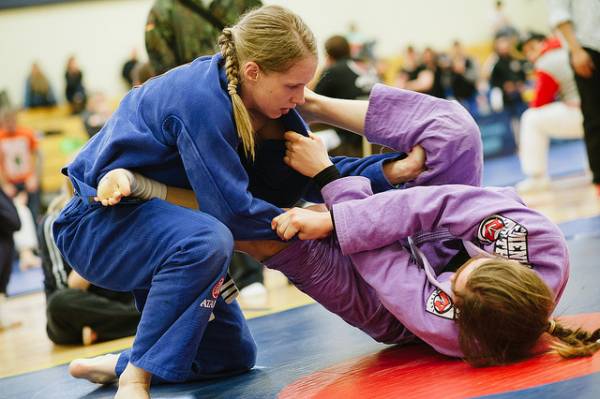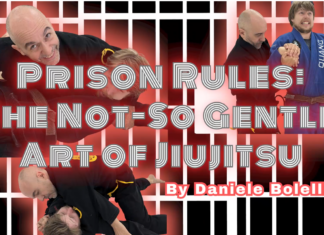
What would you describe as BJJ’s most defining characteristic? The one that makes this art different from other grappling arts? The answer is very easy and can be traced back to the reason BJJ exploded in the first place. During the first couple of UFC events, Royce Gracie amazed the world with his ground fighting abilities. Yes, him choking out huge half naked dudes was impressive, but not unheard of. What really caught the public’s eye was his ability to be deadly from his back. That is the one are that BJJ excels at more than any other art. So the answer to the question above would be the BJJ guard.
The BJJ guard is a very broad term that refers to a whole host of positions. From simple details to huge body positioning changes, the BJJ guard game is unrivaled in it’s efficacy. No other grappling art ever produced a system for offensive fighting from the back as the BJJ guard. For the purpose of this article, we’re going to look at the structure of the most common categories of guards specific to Jiu Jitsu.
The Closed BJJ Guard
The closed guard is perhaps the most recognizable of the guard categories. Who can forget Royce Gracie, and later many others in Pride FC, giving hell to everyone from the ground. The closed guard is one of the basic positions taught in the first few classes of BJJ. Although it’s efficiency is undisputed, the closed guard is not just one position. Is can be considered a whole subsystem of positions and moves, all part of the bigger system known as the BJj guard.
In terms of working from the closed guard in a Gi environment, the closed guard is a go-to for many grapplers. It works from white, all the way to black belt level, offering great control and plentiful attacking options. Sleeve and collar grips help a student control the upper body, while the crossed legs block the hips. From there, it’s all about sweeping or submitting, both done almost effortlessly with the right approach.
The closed BJJ guard for No-Gi gets a bit trickier, mainly because of the lack of high controlling grips. This leads to closed guard varieties that emphasize breaking the posture, to be considered more effective. Among the many variations the one that stands out is the rubber guard. Proven in both BJJ and MMA environments the only drawback of the rubber guard is that it requires a certain level of flexibility. Other, less demanding, but equally effective variations would be the Williams guard, Rat Guard and the Marshall guard.
The Open BJJ Guard
Probolay the most utilized and most varied position in BJJ, the open guard is by far the most entertaining system. Arguably, it offers less control than the closed guard, but is more offensive in a wider variety of ranges. For example, the closed guard can only be played while the opponent is on their knees. Playing open guard means that you can follow an opponent who is changing range, by switching among the many available options.
For example the butterfly guard is great for kneeling opponents. A half kneeling opponent might be kept at bay with the Single Leg X or regular X guard. Against a standing opponents one might go for any De La Riva guard variations when looking for lower body control, or choose spider guard for upper body control. The inverted guard is a story of it’s own, but it does fall under the open guard subsystem.
The BJJ Half Guard
The third big subsystem of the BJJ guard game is the half guard. Again, it is mostly effective against an opponent that is not standing, but it does offer more variety than the closed guard. The half guard has become one of the most powerful attacking positions in BJJ, favoured highly by some of the greatest competitiors at the highest levels. Caio Terra is one who has an unpassable and highly dangerous half guard.
The many varieties of the half guard range from “simple” stuff done off an underhook to highly attractive positions like Cyborg’s tornado guard. This subsystem offers both great controlling positions like the lockdown, as well as unstoppable sweeping variations like the underhook or deep half guard. The half guard game is a good backup for the open guard game as well. Let’s say an open guard gets passed. Instead of ending up in bottom side control, the half guard is right there, offering better options. It can be used as an attacking point of it self, or as a waypoint that can lead to both closed or open guard. the opportunities are endless, aren’t they?
Keep Rollin’
The Best Open Guard Retention Concept video you will ever Watch!


![Darce Choke Encyclopedia – Origins, Mechanics and Variations [2025] BJJ, choke, Brabo, BJJ Darce Choke, D'arce Choke, Darce BJJ Choke](https://bjj-world.com/wp-content/uploads/2017/11/JungPoirierLeeYahoo-218x150.jpg)















![Jiu-Jitsu For Old Guys Guard Retention Bernardo Faria DVD Review [2025] Jiu-Jitsu For Old Guys Guard Retention Bernardo Faria DVD Review](https://bjj-world.com/wp-content/uploads/2025/03/old-guys-guard-retention-bernardo-faria-dvd-review-218x150.png)
![X-Guard Trickery Kyle Sleeman DVD Review [2025] X-Guard Trickery Kyle Sleeman DVD Review](https://bjj-world.com/wp-content/uploads/2025/03/x-guard-trickery-kyle-sleeman-dvd-review-218x150.png)
![Countering with Crab Ride Anthony Budion DVD Review [2025] Countering with Crab Ride Anthony Budion DVD Review](https://bjj-world.com/wp-content/uploads/2025/03/countering-with-crab-ride-anthony-budion-dvd-review-218x150.png)
![Closet Closed Guard Craig Jones DVD Review [2025] Closet Closed Guard Craig Jones DVD Review](https://bjj-world.com/wp-content/uploads/2025/03/closet-closed-guard-craig-jones-dvd-review-218x150.png)
![Xanadu Back Takes Levi Jones-Leary DVD Review [2025] Xanadu Back Takes Levi Jones-Leary DVD Review](https://bjj-world.com/wp-content/uploads/2025/03/xanadu-back-takes-levi-jones-leary-dvd-review-218x150.png)


![Underhooks With Uncle Jeff Glover DVD Review [2025] Underhooks With Uncle Jeff Glover DVD Review](https://bjj-world.com/wp-content/uploads/2025/02/underhooks-with-uncle-jeff-glover-dvd-review-100x70.png)
![Breaking Their Guard Mikey Musumeci DVD Review [2025] Breaking Their Guard Mikey Musumeci DVD Review](https://bjj-world.com/wp-content/uploads/2025/02/breaking-their-guard-mikey-musumeci-dvd-review-100x70.png)

![Just Pass Jay Rodriguez DVD Review [2024] Just Pass Jay Rodriguez DVD Review](https://bjj-world.com/wp-content/uploads/2024/11/just-pass-jay-rodriguez-dvd-review-100x70.png)



![Leg Lock Stock And Barrel Taylor Pearman DVD Review [2025] Leg Lock Stock And Barrel Taylor Pearman DVD Review](https://bjj-world.com/wp-content/uploads/2025/03/leg-lock-stock-and-barrel-taylor-pearman-dvd-review-100x70.png)
![Dima Murovanni Kill The Collar Tie BJJ Trendsetters DVD Review [2024] Dima Murovanni Kill The Collar Tie BJJ Trendsetters DVD Review](https://bjj-world.com/wp-content/uploads/2024/09/dima-murovanni-kill-the-collar-tie-dvd-review-100x70.png)
![Master The Move Anaconda Strangle John Danaher DVD Review [2025] Master The Move Anaconda Strangle John Danaher DVD Review](https://bjj-world.com/wp-content/uploads/2025/02/anaconda-strangle-john-danaher-dvd-review-100x70.png)
![Zen Guide To Submission Grappling Margot Ciccarelli DVD Review [2025] Zen Guide To Submission Grappling Margot Ciccarelli DVD Review](https://bjj-world.com/wp-content/uploads/2025/02/submission-grappling-margot-ciccarelli-dvd-preview-100x70.png)

![Spider and Lasso Guard Jared Welman DVD Review [2025] Spider and Lasso Guard Jared Welman DVD Review](https://bjj-world.com/wp-content/uploads/2025/01/spider-and-lasso-guard-jared-welman-dvd-review-100x70.png)



![Crossing and Spinning Steps To Attack Israel Hernandez DVD Review [2024] Crossing and Spinning Steps To Attack Israel Hernandez DVD Review](https://bjj-world.com/wp-content/uploads/2024/09/spinning-steps-to-attack-israel-hernandez-dvd-review-100x70.png)


![Front Headlock and Turtle Escapes Brian Glick DVD Review [2024] Front Headlock and Turtle Escapes Brian Glick DVD Review](https://bjj-world.com/wp-content/uploads/2024/11/headlock-and-turtle-escapes-brian-glick-dvd-review-100x70.png)



![Advantage Over Time Outside Passing Jozef Chen DVD Review [2025] Advantage Over Time Outside Passing Jozef Chen DVD Review](https://bjj-world.com/wp-content/uploads/2025/03/outside-passing-jozef-chen-dvd-review-100x70.png)

![Grappling Takedown Dominance Brandon Ruiz DVD Review [2025] Grappling Takedown Dominance Brandon Ruiz DVD Review](https://bjj-world.com/wp-content/uploads/2025/01/grappling-takedown-dominance-brandon-ruiz-dvd-review-100x70.png)

![Knee Lever John Wayne Sweep Adam Wardzinski DVD Review [2024] Knee Lever John Wayne Sweep Adam Wardzinski DVD Review](https://bjj-world.com/wp-content/uploads/2024/12/john-wayne-sweep-adam-wardzinski-dvd-review-100x70.png)